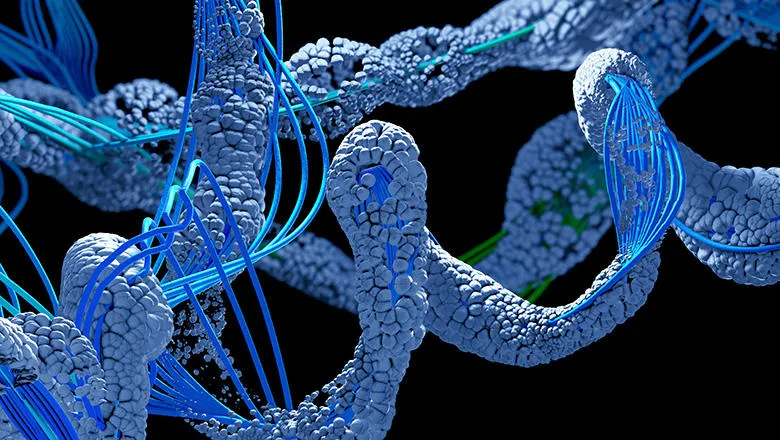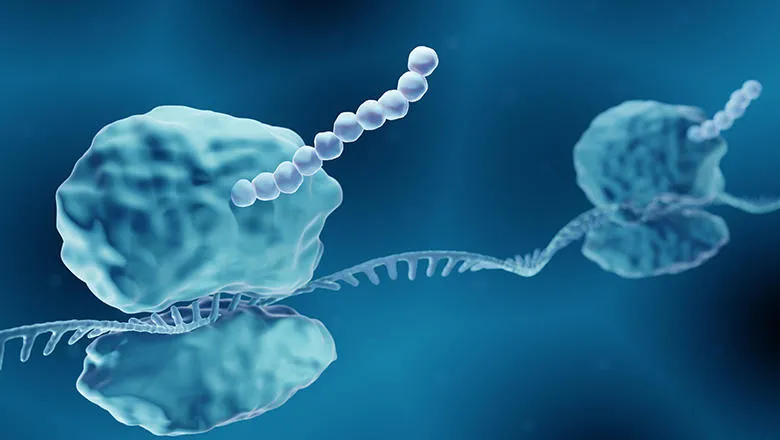By assessing what impact force has on proteins in the human body, we can get a much more accurate picture of how cells work. By knowing how cells self regulate, we’ll eventually be able to develop treatments for conditions like cystic fibrosis and new strategies to tackle infection.
Professor Paula Booth
24 November 2023
Fundamental research into proteins in the cell membrane receives BBSRC Pioneer Award
The first-of-its-kind exploratory study will examine how force impacts assembly for critical proteins in the body.

Professors Paula Booth and Sergi Garcia-Manyes have been awarded a prestigious Biotechnology and Biological Sciences Research Council (BBSRC) Pioneer Award for their work developing an experimental method to examine the role of force in the natural production of proteins in the cell membrane.
Given to original, early-stage research projects with the potential to transform fundamental understandings of biological systems, studies awarded by the BBSRC seek to lay the knowledge foundations for future paradigm-shifting application. By uncovering an accurate picture of how proteins assemble themselves in the cell membrane, this work hopes to better understand the consequences of mis-assembly as well as revolutionise ways to treat disease.
Proteins are naturally occurring strings of amino acids that are present in all living organisms and are essential biological components that function as ‘worker molecules’ throughout Nature, with examples like insulin and antibodies performing vital functions in the body.
Proteins are found both within cells and within cell membranes, which function as the boundary between the inside of a cell and the surrounding environment. These membrane proteins control vital functions within the cell, including controlling the flow of items in and out of the cell and energy production as well as pumping drugs out of cells during antibiotic resistance. As a result, they are often the targets of drugs attempting to treat disease.
Proteins’ ability to properly carry out their function is dependent on the shape a cell folds their amino acids in. Many diseases are caused by protein misfolding but work in this area is heavily focussed on proteins inside cells, whilst the results of membrane protein misfolding are largely unknown. The latter are very likely to make major contributions to areas such as neurodegenerative diseases, like Parkinson’s.
While technical advances in the use of microscopes, such as electron microscopy, have enabled scientists to study static structures of proteins within the membrane environment, studies of how movement and force impact these membrane proteins have been limited.
Complications with proteins within the membrane can cause problems like cystic fibrosis, and we know that as we age the membrane tends to stiffen and that misfolding of vision receptors impacts our eyesight. But we’re just not sure how this happens yet."
Professor Paula Booth
By creating a test environment that enables the researchers to test the impact of force on how proteins assemble and function in the cell membrane for the first time, they hope to form an accurate picture of how this folding is regulated by the cell and when regulation fails.
Professor Booth, Daniell Chair of Chemistry and Co-Director of the Centre for the Physical Science of Life, said “We know comparatively little about the folding and assembly of proteins in the membrane despite their importance. These proteins act as cellular gatekeepers providing the ultimate cellular security with tight control of entry and exit of molecules and information in and out of the cell.
“This means that the membrane barrier is a key point of entry for both infectious pathogens and the drugs that can help treat them. Complications with proteins within the membrane can cause problems like cystic fibrosis, and we know that as we age the membrane tends to stiffen and that misfolding of vision receptors impacts our eyesight as we age. But we’re just not sure how this happens yet.
“By devising a new approach where we can test what impact force has on these vital building blocks of the human body, we can get a much more accurate picture of the dynamics of the folding protein within the membrane, to ultimately understand how cells work. By knowing the red lines of self-regulation, we’ll eventually be able to develop treatments for conditions like cystic fibrosis and new strategies to tackle infection. But more than that, with a better knowledge of how proteins in the cell operate we’ll have a much better idea of how to design powerful natural catalysts for a range of tasks undertaken in the body.”

The researchers hope that eventually, with a greater knowledge of how the cell membrane works, drug developers will be able to rectify folding defects or replace improperly folded proteins. These proteins could be delivered through artificially created cells to the target area, which may be less likely to be rejected by host cells than traditional treatments.
The experiment will be conducted by using a novel instrument built by Professor Garcia-Manyes which will exert a pulling force on an individual membrane protein as it is being made using magnetic beads. The specifics of how exactly this pulling force impacts the way proteins fold in a membrane by the cell will then be studied by Professor Booth.
The work completed as part of the BBSRC Pioneer Award will form part of a wider approach taken by King’s Centre for the Physical Sciences of Life which will use the principles of physical science to advance understanding of the fundamental mechanisms underpinning living biological systems.


